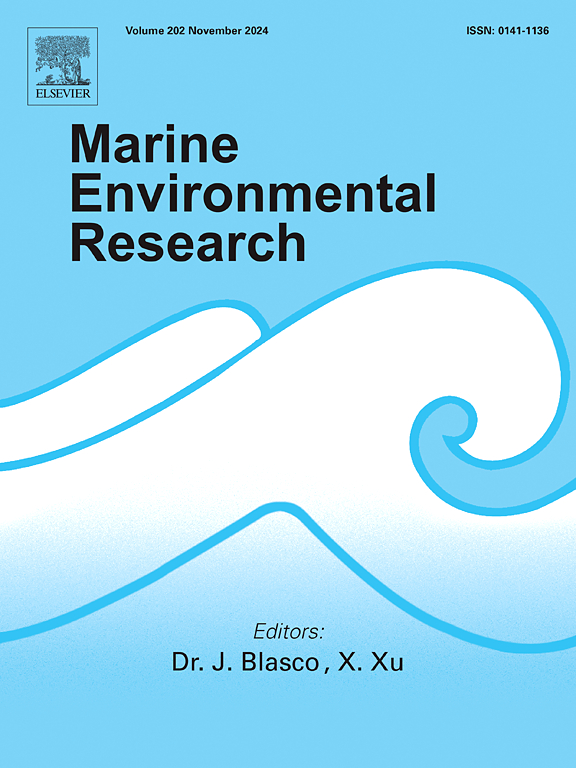Ecotype-specific light intensity responses in Sargassum horneri: bloom-forming vs. benthic forms
IF 3.2
3区 环境科学与生态学
Q2 ENVIRONMENTAL SCIENCES
引用次数: 0
Abstract
This study compared light-driven physiological adaptations between floating and benthic Sargassum horneri ecotypes using five light intensities (50, 100, 150, 300, and 600 μmol photons m−2 s−1). Both ecotypes showed bell-shaped relative growth rate (RGR) curves, with floating S. horneri peaking at 6.74 % day−1 at 150 μmol photons m−2 s−1 and benthic ecotype reached its highest RGR of 6.90 % day−1 at 300 μmol photons m−2 s−1. At 600 μmol photons m−2 s−1, both the maximum photochemical efficiency (Fv/Fm) and the maximum relative electron transfer rate (rETRmax) of the two ecotypes were observed to be inhibited. Notably, the inhibition was more pronounced in the floating S. horneri. Simultaneously, both ecotypes exhibited resilience to elevated light stress by curtailing pigments synthesis, enhancing the light saturation point (Ik) and tissue carbon storage, and elevating catalase (CAT) and glutathione reductase (GR). The concentrations of soluble proteins and UV-absorbing compounds in benthic S. horneri were significantly greater than those found in floating S. horneri at light intensities of ≥300 μmol photons m−2 s−1. The results highlight ecotypes-specific physiological adaptations of S. horneri to varying light intensities. In comparison to the floating S. horneri, the benthic S. horneri collected during the same period exhibited a greater resilience and photosynthetic performance under higher light conditions. The study suggests that benthic S. horneri, if dislodged to surface waters, could proliferate rapidly under transient high-light exposure due to its robust photosynthetic plasticity.
马尾藻的生态型特异性光强响应:开花形成与底栖生物形式。
本研究利用5种光强(50、100、150、300和600 μmol光子m-2 s-1)比较了浮游和底栖马尾藻生态型的光驱动生理适应。两种生态型的相对生长率(RGR)均呈钟形曲线,其中浮藻在150 μmol光子m-2 s-1时最高,为6.74%;底栖生态型在300 μmol光子m-2 s-1时最高,为6.90%。在600 μmol光子m-2 s-1下,两种生态型的最大光化学效率(Fv/Fm)和最大相对电子传递率(rETRmax)均受到抑制。值得注意的是,对漂浮的霍氏梭菌的抑制作用更为明显。同时,两种生态型均通过抑制色素合成、提高光饱和点(Ik)和组织碳储量、提高过氧化氢酶(CAT)和谷胱甘肽还原酶(GR)表现出对高光胁迫的适应能力。在≥300 μmol光子m-2 s-1的光强下,底栖角藻的可溶性蛋白质和吸收紫外的化合物浓度显著高于漂浮角藻。结果突出了不同生态型的角孢菌对不同光强的生理适应。与漂浮的角藻相比,同一时期收集的底栖角藻在更高的光照条件下表现出更强的恢复能力和光合性能。该研究表明,底栖动物S. horneri如果被移到地表水中,由于其强大的光合可塑性,可以在短暂的强光照射下迅速增殖。
本文章由计算机程序翻译,如有差异,请以英文原文为准。
求助全文
约1分钟内获得全文
求助全文
来源期刊

Marine environmental research
环境科学-毒理学
CiteScore
5.90
自引率
3.00%
发文量
217
审稿时长
46 days
期刊介绍:
Marine Environmental Research publishes original research papers on chemical, physical, and biological interactions in the oceans and coastal waters. The journal serves as a forum for new information on biology, chemistry, and toxicology and syntheses that advance understanding of marine environmental processes.
Submission of multidisciplinary studies is encouraged. Studies that utilize experimental approaches to clarify the roles of anthropogenic and natural causes of changes in marine ecosystems are especially welcome, as are those studies that represent new developments of a theoretical or conceptual aspect of marine science. All papers published in this journal are reviewed by qualified peers prior to acceptance and publication. Examples of topics considered to be appropriate for the journal include, but are not limited to, the following:
– The extent, persistence, and consequences of change and the recovery from such change in natural marine systems
– The biochemical, physiological, and ecological consequences of contaminants to marine organisms and ecosystems
– The biogeochemistry of naturally occurring and anthropogenic substances
– Models that describe and predict the above processes
– Monitoring studies, to the extent that their results provide new information on functional processes
– Methodological papers describing improved quantitative techniques for the marine sciences.
 求助内容:
求助内容: 应助结果提醒方式:
应助结果提醒方式:


